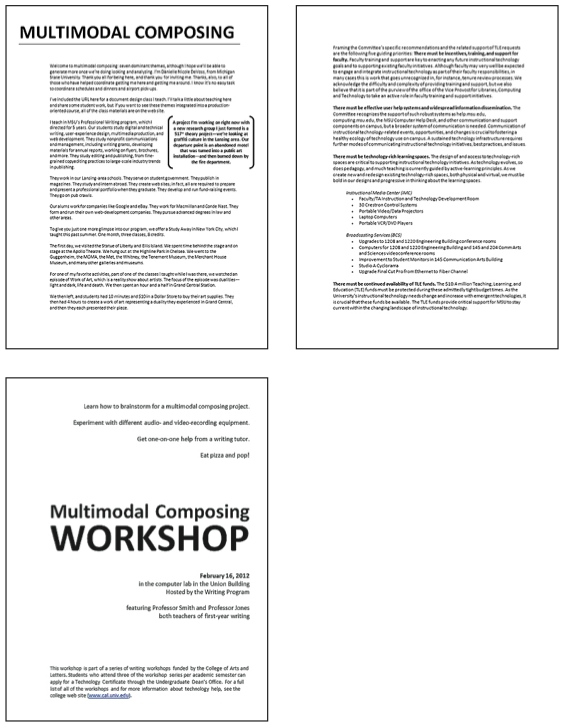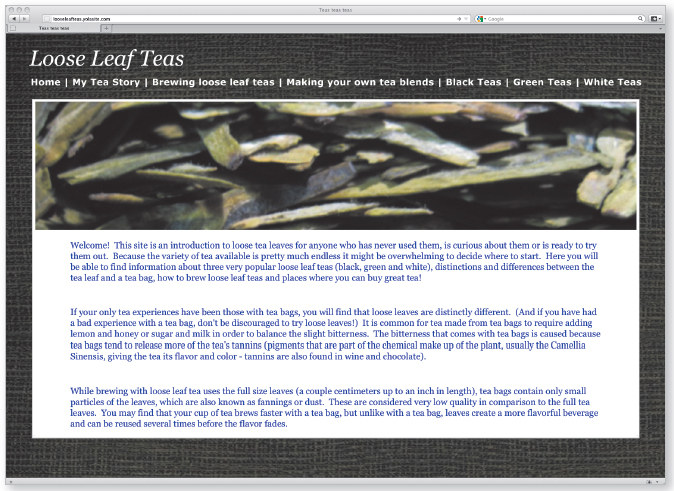MM12-b Choosing a strategy for creating emphasis
In a text-only document with minimal design, the words themselves carry importance; that is, how you format words and sentences and where you place them help provide emphasis. You would probably express an important idea in a topic sentence at the start of a paragraph, for example, rather than bury it in the middle of a long paragraph. In a text-only document with design features, important ideas can be emphasized with font choice and by styling words with boldface, underline, italics, and type size. Look at the documents in Figure 12-3. From a glance, what would you assume to be the most important information in each one?
The large boldface text in the first and third examples is likely the most important information. The first example also includes a “pull quote,” which draws readers’ eyes to the right side of the page. The second example includes some boldface text and a bulleted list, which help key information stand out from the rest of the text. In the third example, readers might assume that the text block at the bottom of the page is less important than the spaced-out, right-aligned text at the top of the page.
Consider the front page of Alyson D’Amato’s Web site (Figure 12-4). Perhaps the most important information on the front page is the list of links at the top of the page, which allows readers to see the different topics addressed on the Web site and to go to the different pages of the site. This navigation bar stays at the top of each page, so readers can easily move around on the site from whichever page they land on. D’Amato has also emphasized the photo of tea leaves—with her audience (tea novices) in mind.
On the Web site home page, the body text appears in somewhat standard-size text, organized into paragraphs. The front page text is important, but perhaps not as important as the navigation bar.
If you listen to student composer Marisa Williamson’s video, which argues that tragedies—even those experienced only on YouTube—knit us together, you’ll notice that she repeats some audio clips throughout the video. This repetition of information makes it stand out as particularly important.
She repeats three key audio clips across her work:
- “The world is very different now.” (John F. Kennedy)
- “Now is the time.” (Martin Luther King Jr.)
- “We cannot turn back.” (Martin Luther King Jr.)
These clips contribute to her main idea that online video is now one of the primary ways that we experience formative events. She deliberately chose not to repeat a phrase that John F. Kennedy is perhaps most famous for: “Ask not what your country can do for you—ask what you can do for your country.” Because this famous line is heard only once in Williamson’s composition, it stands out as being particularly meaningful.
Another way that the student creates dramatic emphasis is by beginning and ending with audio clips of Ronald Reagan, US president in 1986 when the space shuttle Challenger disaster occurred.
You have a number of strategies for emphasizing important information at your disposal as you craft a multimodal piece. In a PowerPoint slide, you might style headings so that they communicate your key ideas prominently, and you might use bullet points to emphasize steps or points in your presentation. In an advertisement, you might add white space around a product shot to call attention to it. In a podcast, you might pause and use silence for emphasis. In a video, you might use subtitles to reinforce a message. Considering your purpose for composing, determining your audience, and understanding the genre in which you are composing are important steps in figuring out how to make an impact.

